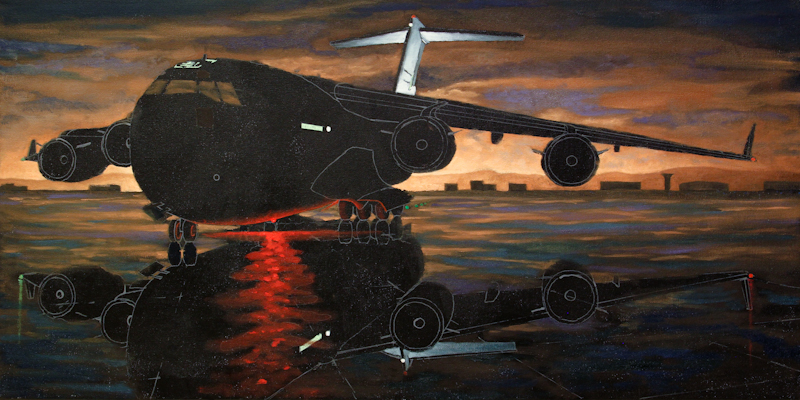This evening I updated the sky and the tarmac to look like the study and I painted the light washing over the vertical stabilizer. The illuminated vertical stabilizer is important because it allows me to use a very light salmon near the horizon and still have the painting read as a nocturne. When painting a nocturne, one constantly has to use tricks like this to avoid a dark painting.
Before starting, I mixed three strings of Winsor & Newton Artisan Water Mixable Oil Colors. The first string was a salmon color consisting of Burnt Sienna and Cadmium Yellow Pale Hue (Hansa Yellow), lightened with Titanium White and darkened with Burnt Umber. The second was a pastel violet consisting of French Ultramarine, Cadmium Red Hue (Naphthol Red), and Titanium White. The third string was a cool green consisting of French Ultramarine, Cadmium Yellow Pale, and Titanium White.
The sky is salmon and violet with a few dabs of pure French Ultramarine in the corners. Since I was painting the new colors over the previous, monochromatic sky, I started by painting the clouds with the salmon, then worked the violet into the darker regions in between. If I do a bigger version of this painting, I will start the sky with a smooth violet gradient and then work in the salmon clouds wet on wet. This will be much easier and look just as good.
The tarmac is broken color using the dark end of all three strings plus a mixture of French Ultramarine and Prussian Blue for the darkest puddles. I spent quite a while with three brushes in my hand, carefully bringing the value up as much as possible in order to make the reflection of the dark fuselage show.
I used the light end of the green string for the vertical stabilizer. My next pass will take the bottom of the tail almost up to pure white.
The next session should bring in the highlights on the leading edge of the wing and the engine nacelles.

